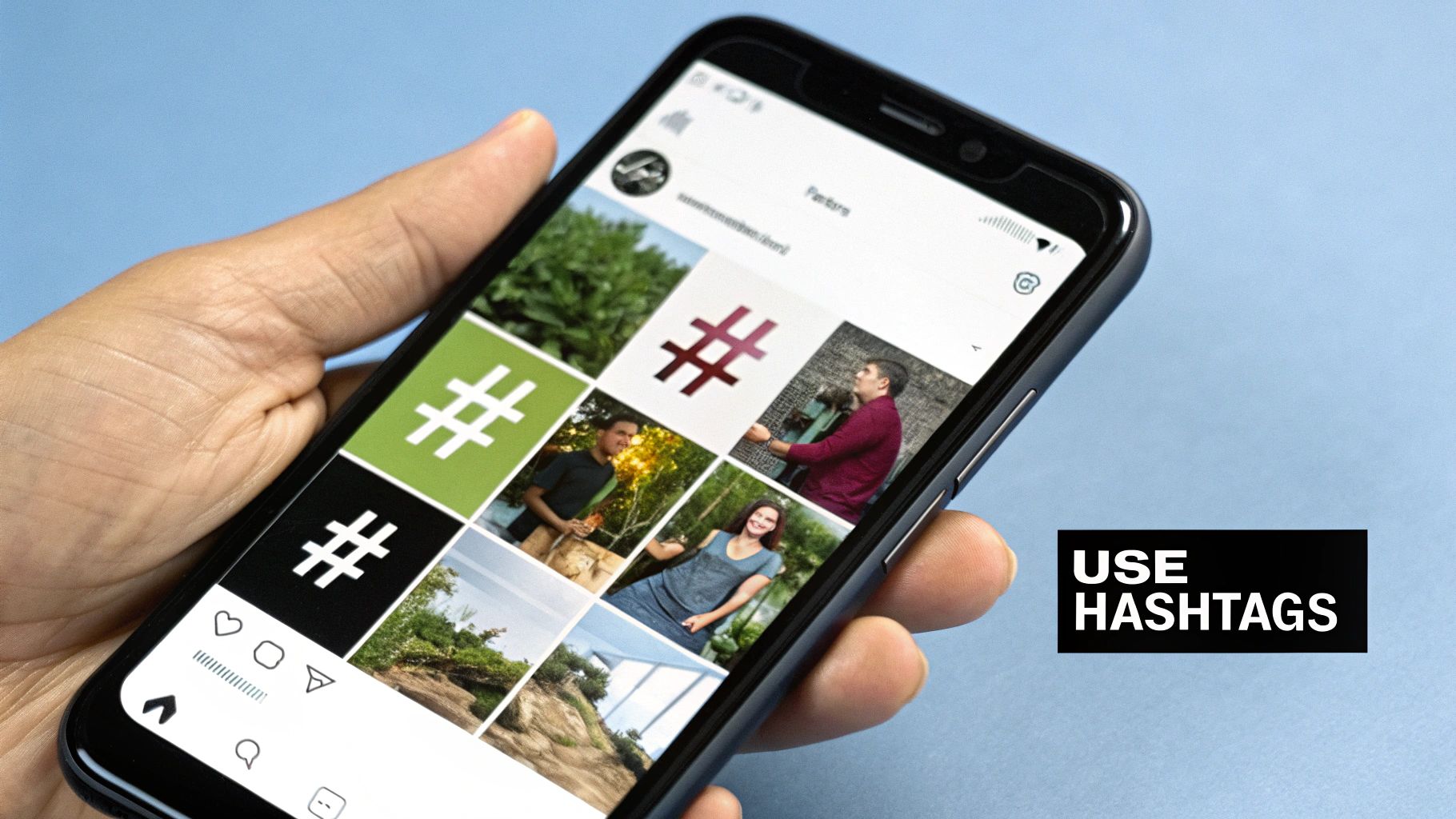Let's be real for a moment: creating social media content that actually works isn't about just posting whenever you feel like it. It's a serious discipline. It's where brands are built, communities are formed, and conversations happen. This guide is designed to cut through the fluff and give you a practical, real-world workflow for making content that truly connects.
The Reality of Modern Social Media Content

The social media world is crowded, to say the least. It’s competitive, and the rules seem to change every other day. To stand out, you need more than just a few good ideas—you need a solid process that turns those ideas into great posts, consistently.
This guide is all about building that repeatable system. We're moving away from the frantic scramble to find something to post today and toward a structured approach that top creators use. We’ll build a workflow that takes you from the first spark of an idea all the way to hitting "publish."
The Scale of the Opportunity
The numbers here are just staggering. Globally, there are over 5.24 billion active social media user identities. That's more than 60% of the entire world's population, and it's still growing. The potential reach is massive.
And with the rise of new tools, the game has changed. A whopping 90% of companies using generative AI report significant time savings in their content process. You can dig into more of these social media statistics to see how they're shaping modern marketing.
The real challenge isn't just making more content; it's making content that connects. In a world of endless scrolling, your posts have to earn that split-second of attention by offering real value, sparking curiosity, or solving a problem.
The Core Pillars of a Modern Content Workflow
To bring some order to the chaos, it helps to break down the content creation process into a few core stages. Each one has a clear goal, and with the right tools, you can manage them without pulling your hair out. We’ll use a tool like TNote to show how you can keep every stage organized and moving forward.
Here’s a quick overview of the essential stages in a modern content workflow. We’ll be diving deep into each of these throughout this guide.
| Workflow Stage | Key Objective | Primary Tool in TNote |
|---|---|---|
| Strategic Foundation | Define your audience, content pillars, and research your space. | Note Boards & Research Logs |
| Creative Production | Brainstorm ideas, write copy, and create visuals. | Idea Backlogs & Content Canvases |
| Optimization & Publishing | Tailor content for each platform, schedule posts, and analyze performance. | Content Calendar & Analytics Dashboard |
Think of these pillars as the foundation of your entire social media strategy. Get them right, and you'll have a repeatable system that not only saves you time but also produces better, more impactful content.
Building Your Strategic Content Foundation

Let's be honest. Outstanding social media content doesn't just happen by accident—it’s the outcome of a deliberate, well-thought-out strategy. That frantic, "Oh no, what should I post today?" feeling is a classic symptom of a weak foundation.
To build a solid one, you need a central command center for your ideas, research, and plans. This is exactly where a tool like TNote becomes your best friend. Instead of having insights scattered across random docs and apps, you can create a single, unified workspace. This space becomes the strategic core for your brand, holding everything from deep competitor analysis to detailed audience profiles. When you approach content this way, every single post has a purpose and pushes you toward a bigger goal.
Define Your Audience First
Before you can write a single word that truly connects, you have to know exactly who you're talking to. Generic content speaks to precisely no one. The first real step is to build out detailed audience personas, and you can do this right inside a TNote project board.
Let's say you're a brand selling eco-friendly backpacks. Your ideal customer, "Eco-conscious Ethan," is way more than just a demographic. You'd create a card that dives deep into his values, his problems, and where he hangs out online.
- Values: He cares deeply about sustainability, ethical manufacturing, and getting outdoors.
- Pain Points: His biggest struggle is finding durable gear that actually aligns with his environmental beliefs.
- Social Habits: You'll find him following hiking influencers on Instagram, engaging with transparent brands, and participating in sustainability forums.
By keeping this persona front and center in your workspace, your entire team can craft content that speaks directly to Ethan, not just some fuzzy idea of a customer.
Establish Your Content Pillars
Once you know your audience inside and out, it's time to set up your content pillars. Think of these as the 2-4 core themes or topics your brand will own and talk about consistently. They're your guideposts, making sure your content stays focused and relevant.
Your content pillars live at the intersection of what your audience genuinely cares about and what your brand stands for. They stop your feed from feeling like a random jumble of posts and turn it into a cohesive, compelling brand story.
For our eco-backpack brand, the pillars might look something like this:
- Sustainable Living Tips: Content that helps Ethan live a more eco-friendly life, even beyond just buying a backpack.
- Adventure & Exploration: Jaw-dropping landscapes and stories of how the gear enables unforgettable journeys.
- Behind the Brand: A transparent look at the materials, the people, and the ethical processes behind the products.
- Product in Action: Real-world photos, user-generated content, and high-quality shots of the backpacks out on the trail.
You can easily create a separate board or even just a list in TNote for each pillar. This makes it incredibly simple to see at a glance if you’re balancing your content or if you're accidentally leaning too heavily on one topic.
Create a Research and Inspiration Hub
Finally, every good strategy needs a dedicated spot for ongoing research and inspiration. Staying on top of what's happening in your industry is non-negotiable. I recommend creating a specific "Research & Inspiration" board in TNote.
This is your digital scrapbook. Use it to save screenshots of competitor ads you love, links to articles on emerging trends, and notes on what your audience is buzzing about online.
For example, if you see a competitor's post blow up with engagement, don't just scroll by. Screenshot it, toss it onto your board, and add a quick note: "This carousel format worked wonders for them. The '5 Ways to Pack Lighter' angle really connected. We could do a similar take for our 'Sustainable Living' pillar."
This simple habit turns passive scrolling into active research. Before you know it, you'll have a rich library of insights that powers a repeatable, effective content machine.
Bringing Your Content Creation Workflow to Life

Alright, you've got your strategy locked in. Now comes the fun part: turning those big-picture plans into actual, scroll-stopping content. This is where the rubber meets the road, moving from high-level ideas to polished posts that are ready to hit your audience's feeds.
Without a solid workflow, content creation can feel like total chaos. A well-oiled process, on the other hand, keeps a steady stream of high-quality posts coming. This is where a central hub like TNote becomes your best friend, managing everything from the initial spark of an idea to the final design approval, all in one place.
From Brainstorm to Production
Every great post starts as a simple idea. I've found the best way to keep track of these is with a dedicated "Idea Backlog" in TNote. Think of it less like a static list and more like a dynamic incubator for your concepts.
For instance, if I were running social for a fitness brand, a concept card might look something like this:
- Post Idea: "3 Common Kettlebell Swing Mistakes to Avoid"
- Content Pillar: Educational / How-To
- Format: Short-form video for Reels/TikTok, plus a summary carousel for Instagram.
- Key Talking Points: Hip hinge vs. squat, keeping the back straight, controlling the downswing.
- Status: Idea Stage
This simple structure cuts through the noise. When you're ready to start creating, you simply drag the card from your "Idea" column to "In Production." Just like that, your team knows work has officially begun.
Building a Balanced Content Calendar
Your content calendar is your roadmap, and it needs to be dynamic. It's how you make sure you're mixing up different formats and themes to keep your audience from getting bored. A little variety—a blend of video, static images, carousels, and text-only posts—goes a long way.
Today’s social media user is platform-agnostic. On average, users engage with approximately 6.83 different social networks each month. This means your social media content creation must be adaptable to fit the unique culture of each platform. To see more on how user habits are changing, you can explore the latest social media statistics from Sprout Social.
This is precisely why a visual calendar is so powerful. You can tell at a glance if you're hitting LinkedIn too hard with promos or neglecting video on Instagram.
Managing the Production Pipeline
Once a post moves into production, clear steps are everything. In TNote, you can attach simple checklists to each content card, which saves you from endless back-and-forth status meetings. Managing the whole process is much easier with a robust tool, and you can explore TNote's powerful editor to see how it works for yourself.
Here’s a sample production checklist I might use for a single post:
- Copywriting: Draft the caption, headline, and call-to-action.
- Visuals: Create the graphics or edit the video footage.
- Review: Get feedback from the team on both copy and visuals.
- Final Polish: Implement feedback and make any final tweaks.
- Ready for Scheduling: Move the card over to the "Approved" column.
This kind of system keeps everyone on the same page and your creative pipeline flowing smoothly. It transforms social media content creation from a reactive scramble into a proactive, organized, and much more effective process.
Optimizing Your Content for Maximum Reach

Let's be real: creating a fantastic piece of content is only half the battle. If no one sees it, what was the point? This is where optimization comes in—the final, critical stage that ensures your hard work gets the eyeballs it deserves. It’s about much more than just hitting "publish"; it's a strategic push to make sure your content actually performs.
This means you have to tailor every single element for the specific platform you're on. A witty, one-line caption might absolutely crush it on X (formerly Twitter), but that same caption would likely fall flat on LinkedIn, where people expect more depth and professional insight. Your whole content creation process needs to account for these subtle differences from the very beginning.
This is where a tool like TNote can be a lifesaver, acting as your pre-publishing command center. Before anything goes live, you can use it to get feedback and final sign-offs, making sure your captions, visuals, and hashtags are all perfectly dialed in. No more last-minute scrambles or embarrassing typos.
Mastering Platform-Specific Nuances
Every social media platform has its own culture, its own unwritten rules, and its own audience expectations. Your job is to play by them. That means taking the time to write a unique caption for each network instead of just copying and pasting the same thing everywhere.
Hashtags are a perfect example. On Instagram, a solid set of 15-20 relevant hashtags can dramatically expand your reach. But try that on LinkedIn or Facebook, and you’ll look spammy and unprofessional. On those platforms, sticking to just 2-3 highly relevant hashtags is the way to go.
The goal is to meet your audience where they are, both physically and mentally. A person endlessly scrolling through TikTok is in a completely different headspace than someone browsing professional articles on LinkedIn. Your content has to respect that context.
Visuals and Timing Are Everything
Just as important as the words you use is how your content looks. A compelling thumbnail for a YouTube video isn't just a nice-to-have; it's often the single biggest factor in getting someone to click. For an Instagram Reel, the first three seconds are do-or-die. You have to hook the viewer instantly, or they're gone.
Timing is another piece of the puzzle. Don't just post whenever you feel like it. Dig into your platform’s native analytics to pinpoint when your specific audience is most active. Then, schedule your content to drop right in that sweet spot to get that crucial initial burst of engagement.
This focus on mobile-first optimization is only getting more important. Marketers are taking notice, with a staggering 93% planning to increase their social media resources in 2025. The money is following, too. Advertising spend on social media is expected to hit $276.7 billion in 2025, with mobile projected to account for a massive 83% of that by 2030. If you want to dive deeper, you can discover more insights on these social media trends from Sprout Social.
Techniques for Truly Engaging Content
So, what separates a good social media post from one that’s truly great? It’s that extra layer of strategic polish—the kind that makes people stop scrolling and actually start looking forward to your content. This is where you move beyond just producing posts and start crafting experiences.
One of the most powerful ways to do this is through storytelling. Seriously. Even the simplest post can be woven into a larger narrative. Instead of just showing a product, tell the story of the problem it solves or the a-ha moment behind its creation. Instead of a generic team photo, share a quick, personal anecdote about a team member's recent win. These stories create an emotional hook that facts and figures just can't match.
Make Your Content Interactive
Another game-changer is designing content that begs for participation. When you do this, you turn passive viewers into active members of your community. It’s all about starting a real, two-way conversation.
You've got a few solid formats to make this happen:
- Polls: Ask your audience to vote on a new product feature, a new flavor, or even weigh in on a fun, industry-related debate. People love sharing their opinion.
- Quizzes: Create a short, entertaining quiz like, "What's Your Remote Work Style?" Something that provides a little value and is super shareable.
- Q&A Sessions: Host a live or post-based Q&A with an expert on your team. This is a fantastic way to build authority and give your audience immense, direct value.
The core idea is simple: give your audience a reason to do more than just tap 'like'. When you ask for their opinion and show you're actually listening, you stop just creating content and start building a community.
Master the Art of Repurposing
Let’s be real: creating stellar content takes time. A lot of it. That's why smart content repurposing isn't just a "nice-to-have" skill—it's non-negotiable for anyone who wants to stay sane. The goal is to take one big piece of content and slice it up into a week’s worth of unique social media assets, getting the most bang for your buck.
For example, a single long-form video—which is a powerhouse for engagement—can be a goldmine. In fact, research shows that a whopping 78% of people prefer discovering new products through short-form video. (If you want to dive deeper into the data, these key social media statistics are worth a read). You can easily chop that one video into several Reels, a compelling quote graphic, and even an audiogram for a podcast teaser.
This approach ensures you have a steady stream of high-quality material without burning out yourself or your creative team. Juggling this kind of multi-asset workflow is where a tool with flexible plans becomes a lifesaver. You can see how TNote's pricing fits teams of all sizes to handle exactly this kind of strategic output.
Wrapping Up: Your Path to Sustainable Content Mastery
We’ve walked through the entire social media content process, from big-picture strategy all the way down to the tiny details that make a post click. If there’s one thing to take away, it’s this: real, long-term success comes from having a system you can rely on, day in and day out.
Bringing a tool like TNote into your workflow isn't just about adding another app to your dock. It’s about clearing out the mental clutter. When the process itself is handled, you can pour your energy into what truly matters—being creative and actually connecting with the people on the other side of the screen. Consistency, solid planning, and knowing who you’re talking to are the bedrock of it all.
Think of this framework less as a strict set of rules and more as a launchpad. It’s your system for turning those fleeting creative sparks into real, tangible results you can be proud of.
As you get into your groove, always keep one eye on what’s next. For example, the AI-powered virtual influencer market is on track to become a $37.8 billion industry by 2030. That's a massive shift, opening up entirely new ways for brands to collaborate. Staying aware of changes like this helps you pivot when you need to. You can dig deeper into these innovative social media avenues with insights from Talkwalker.
So, start small, stick with it, and never, ever stop listening to your audience.
Frequently Asked Questions
Even with a killer workflow in place, questions always pop up in the day-to-day grind of creating social media content. Let's tackle some of the most common hurdles I see people face so you can keep your strategy sharp and moving forward.
How Often Should I Really Be Posting?
Ah, the classic question. The honest, no-fluff answer is: it depends entirely on the platform and your capacity.
Consistency will beat frequency every single time. It's so much better to publish three high-quality, genuinely engaging posts a week on Instagram than it is to churn out seven mediocre ones just to hit a daily quota. You'll burn out and your audience will tune out.
For fast-moving platforms like X (formerly Twitter), you might need to post more often to stay on people's radar. But on a platform like LinkedIn, a couple of deeply insightful posts per week can make a much bigger splash. My advice? Start with a schedule that feels manageable, then dive into your analytics to see what’s actually working. Adjust from there.
The goal isn't to shout into the void every day. It's to show up consistently when your audience is listening, offering value with each post. Quality over quantity will always win the engagement game.
What Do I Do When I Run Out of Ideas?
Creative block is real, and it can feel like hitting a brick wall. But it doesn't have to completely derail your content calendar.
When you feel stuck, go back to your foundations. That "Research & Inspiration" board you set up in TNote should be your first port of call. What are your competitors up to? What questions is your audience asking on forums or in comment sections? What trends are bubbling up in your niche?
Another trick I use all the time is to revisit my best-performing content. Is there a way to create a follow-up post? Can you dive deeper into one specific point from a popular post? Or maybe present the same core idea in a fresh format, like turning a successful blog article into a bite-sized carousel? Don't reinvent the wheel if you don't have to.
How Do I Measure Success Beyond Likes?
Likes are a vanity metric. They feel good, for sure, but they rarely translate into actual business results. If you want to understand your real impact, you need to focus on metrics that signal deeper engagement and genuine interest.
Here are the ones I tell my clients to obsess over:
- Shares and Saves: These are huge indicators of quality. When someone saves your post for later or shares it with their network, it means you've created something genuinely valuable.
- Comments: I'm not talking about one-word replies. Meaningful conversations happening in your comment section are pure gold. It's proof that you're building a real community.
- Click-Through Rate (CTR): If your goal is to drive traffic back to your website or a landing page, this is your north star. It tells you exactly how effective your call-to-action is.
Tracking these numbers gives you a much clearer, more honest picture of what your social media efforts are actually achieving for your brand.
Ready to transform your content workflow from chaotic to clear? TNote makes it simple to turn your ideas and Markdown notes into beautiful, shareable knowledge cards for any social platform. Organize your strategy and create stunning visuals in just one click at https://tnote.ai.